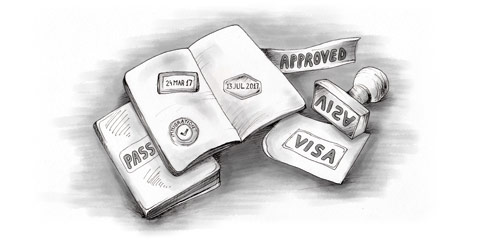Who needs a TIE?
If you need a visa to stay in Spain, you need a TIE. Officially, you need to apply for your TIE within 30 days of your arrival in Spain - however, the waiting time for an appointment is usually more than this. As long as you book your appointment within these 30 days, it’s okay.
How to apply for your TIE
The first step is to make an appointment. To do this;
- Click here - there is info available in EN, but the process for an appointment is broken
- Select Cita Previa Extranjeria and click Acceder al Procedimiento
- In the Provincias Disponibles drop down box, select the appropriate Spanish region and click Aceptar
- In the Trámites Disponibles Para La Provincia drop down box, select Policia-Toma de Huellas (Expedición de Tarjeta) y Renovación de Tarjeta de larga Duración and click Aceptar
- A list of documents you need for your appointment will appear, click Entrar
- Enter your details (use your NIE issued on your visa as Tipo de documento) and the date your visa expires, then click Aceptar
- Select the best appointment for you
- Confirm your appointment and save the PDF appointment confirmation
2) Get organised
Before your TIE appointment, you need to get a Certificado de Empadronamiento and pay the TIE application fee.
Certificado de Empadronamiento
This is proof of your legal Spanish address. The process and forms required are slightly different depending on the region, so you will need to go to a Padrón Municipal in your region and ask what the process is for you.
Pay the fee
Fill in the Modelo 790-012 tax form online, download and print the completed version, then take all pages to a bank. Pay the required fee and get proof of payment.
3) Attend your appointment
On the day of your TIE appointment, go to the appropriate office (this will be listed on your appointment confirmation PDF) with the following documents:
- Your passport and two photocopies of the photo page
- Your visa and one photocopy
- Proof of arrival date and one photocopy
- One recent passport style photo with a white background
- Carta de Nombramiento and two photocopies: this is confirmation of why you are in Spain. For example, if you are working it will be your contract or a letter from your employer, if you are studying it will be proof of university registration, and so forth.
- Certificado de Empadronamiento and one photocopy
- Printed PDF appointment confirmation
- Completed EX-17 application form and one photocopy
- Modelo 790-012 proof of payment
A civil servant will examine all your documents, scan your fingerprints and give you a piece of paper stating a time frame in which you need to return to the office to collect your TIE, e.g. 40-45 days. At the appropriate time, return to the office with your passport, visa and the piece of paper. You will then (finally!) be given your TIE.
Unfortunately, your TIE will feature an expiration date determined by your right to reside in Spain. If circumstances change and you extend your residency, you will need to renew your TIE.
What is proof of arrival date?
When applying for your TIE, you must provide proof of the date you arrived in Spain/the Schengen Area via an entrance stamp in your passport or on your visa. If you travel directly from outside the Schengen Area to Spain, get your passport/visa stamped when you pass through Spanish security.
If you do not travel directly from outside the Schengen Area to Spain - so travel to a different Schengen Area country and then to Spain - it’s a bit more complicated. In this case, you need to get your passport/visa stamped when you pass through security in the first Schengen Area country you arrive in and keep all evidence of onward travel to Spain. For example, if you fly from outside the Schengen Area into France and then travel to Spain by train, get your passport/visa stamped when you pass through French security and keep your train ticket from France to Spain. Take your passport/visa containing your French entrance stamp and your train ticket (from France to Spain) to your TIE appointment.

